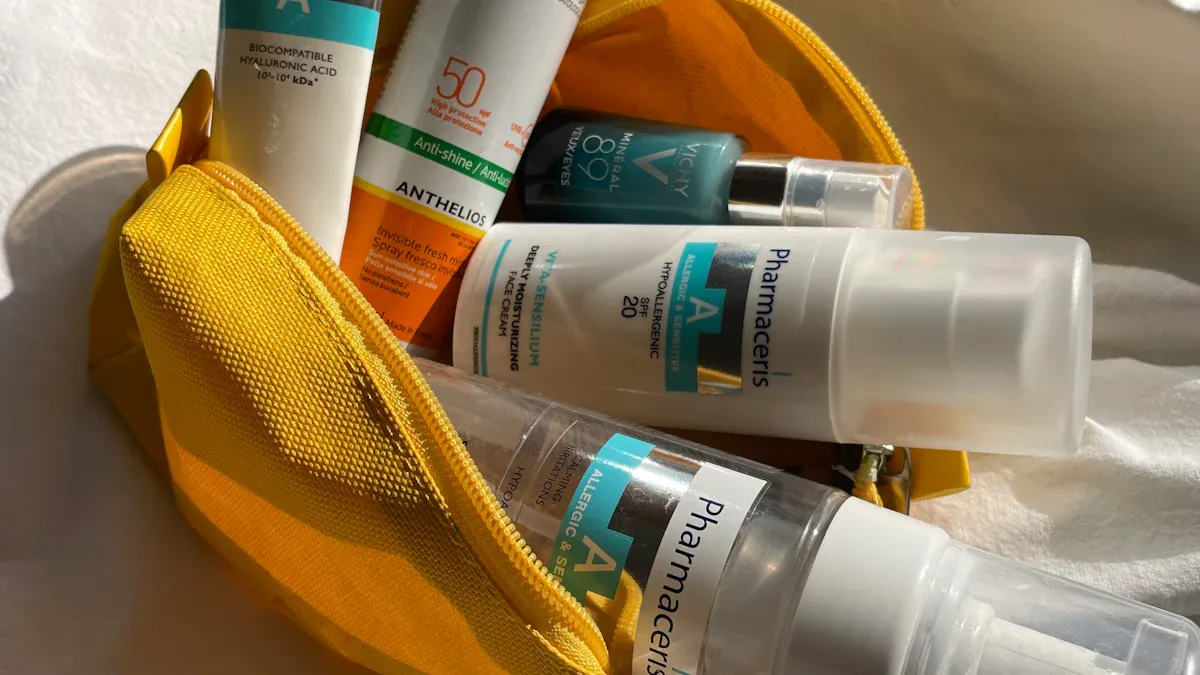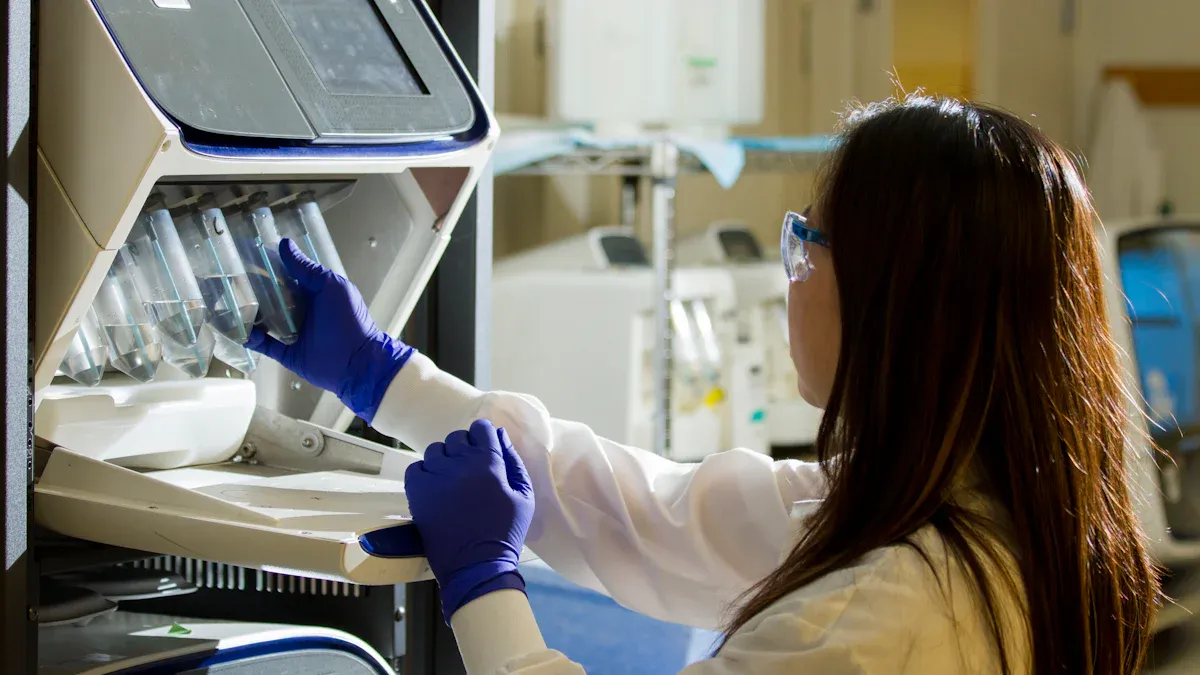How to Ensure Biocompatibility of PET Shrink Tubing in Medical Device Manufacturing

Manufacturers ensure the safety of medical grade PET shrink tubing by conducting thorough biocompatibility testing for medical grade PET shrink tubing and adhering to strict regulations. They select PET heat shrink tubing that complies with ISO 10993-5 and ISO 10993-10 standards. These tests evaluate cell damage and skin irritation. Both in vitro and in vivo biocompatibility testing for medical grade PET shrink tubing confirm its safety after multiple cleaning cycles. Additionally, PET heat shrink tubing must maintain its shape and elasticity following autoclaving, hydrogen peroxide plasma treatment, and gamma irradiation. Producing the tubing in a cleanroom environment and maintaining detailed records further supports compliance and ensures the tubing remains safe for medical applications.
Key Takeaways
Makers check PET shrink tubing very carefully to make sure it is safe. They want to be sure it does not hurt cells or cause allergies. PET shrink tubing needs to stay strong and keep its shape after many cleanings. It also needs to stay the same after sterilizations to keep patients safe. There are strict rules like ISO 10993 and USP Class VI. These rules help guide testing and certification to show the tubing is safe for medical use. Clean factories and good recordkeeping help keep PET shrink tubing high quality. They also help track where each piece comes from. Picking certified materials and using trusted labs makes sure PET shrink tubing meets all safety rules for medical devices.
Biocompatibility in Medical Devices

Patient Safety
Keeping patients safe is the most important goal in making medical devices. Companies test biocompatibility to make sure pet shrink tubing and pet heat shrink tubing are safe to use. These tests check that the tubing does not hurt cells or cause skin problems. They also make sure it does not cause allergies. Medical rules say pet heat shrink tubing must stay strong after being cleaned many times. For example, it keeps over 88% of its strength after 50 cleanings with hydrogen peroxide. This lowers the chance that a device will break. The tubing has a smooth surface, which helps stop bacteria from growing. This helps keep medical tools safe for patients.
Biocompatibility Measure | Quantitative Evidence | Impact on Patient Safety |
|---|---|---|
Tensile Strength Retention | Over 88% retained after 50 sterilization cycles | Ensures material durability and safety after repeated sterilization |
Dielectric Strength | Exceeds 4,000 V/mil | Provides robust electrical insulation, preventing device failures |
Thermal Stability | Onset decomposition temperature 3–19 °C higher than pure PET | Maintains integrity under sterilization and operational heat |
Compliance Standards | Meets ISO 10993 and USP Class VI | Confirms biocompatibility and safety for direct patient contact |
Surface Properties | Smooth surface reduces bacterial growth | Enhances sterility and reduces infection risk during procedures |
Teams who make medical devices watch these things closely. They want to keep patients safe and help them heal faster. Careful testing means fewer problems and quicker recovery.
Regulatory Standards
Medical tools must follow strict rules before doctors can use them. Groups like the FDA, ISO, and USP make these rules for safety and biocompatibility. Pet shrink tubing and pet heat shrink tubing must pass ISO 10993 and USP Class VI tests. These tests look for cell damage, allergies, and skin problems. The Tria valve with LP leaflets passed all ISO 10993 tests. It did not hurt cells or cause irritation, and the results were strong (p < 0.05).
Regulatory Test | Result | Impact on Medical Devices |
|---|---|---|
Cytotoxicity | Noncytotoxic | Safe for direct patient contact |
Sensitization | Nonirritant | Reduces risk of allergic reactions |
Hemolysis | Nonhemolytic | Prevents blood cell damage |
Thrombosis | Superior coagulation profiles | Lowers risk of clot formation |
Genotoxicity | No genotoxic effects | Safe for long-term use in medical equipment |
Manufacturers always follow these tough rules. This makes sure pet heat shrink tubing works well in every medical device. Meeting these standards keeps patients safe and helps make good medical equipment.
Biocompatibility Testing for Medical Grade PET Shrink Tubing

Biocompatibility testing is very important for patient safety. It helps make sure PET shrink tubing is safe for use in the body. Manufacturers must follow strict rules and medical standards. They need to check that PET heat shrink tubing meets all the needed requirements. The process uses many tests and certifications like ISO 10993, USP Class VI, and FDA approval. These standards show that PET shrink tubing stays safe and works well, even after being cleaned many times.
Standard | Purpose |
|---|---|
ISO 10993 | Assesses biocompatibility of medical device materials |
USP Class VI | Certifies materials are free from harmful chemicals |
FDA Approval | Confirms compliance with U.S. safety and effectiveness regulations |
Manufacturers use these rules for every step, from picking materials to final testing. PET heat shrink tubing must keep its good qualities after cleaning. This makes sure it works well for a long time in implantable device sealing.
In Vitro Testing
In vitro testing is the first step in checking biocompatibility. Labs put PET heat shrink tubing samples with cells and watch for reactions. These tests include cytotoxicity, sensitization, and irritation checks. Cytotoxicity looks for cell harm or death. Sensitization checks for allergic reactions. Irritation tests see if the tubing causes redness or swelling.
Note: ISO 10993 says all medical devices that touch the body, like PET shrink tubing, need in vitro testing.
Manufacturers use these test results to make sure PET heat shrink tubing does not give off harmful things during cleaning or use. The tubing must pass these tests before moving to in vivo studies. In vitro testing also helps find problems from making the tubing or from things that break down, which could make implantable devices unsafe.
In Vivo Testing
In vivo testing is the next step in biocompatibility testing. Scientists put PET heat shrink tubing on or in living tissue, often in animals, to see what happens. These tests follow ISO 10993 and USP Class VI rules. They look for problems like body-wide toxicity, local tissue reactions, and long-term safety.
PET heat shrink tubing should not cause swelling, infection, or tissue harm. The FDA and ISO 10993 say these tests are needed for devices that stay in the body for a long time. In vivo testing also checks if the tubing stays strong after cleaning and use. This makes sure PET shrink tubing does not break down in a way that could hurt patients.
Regulatory Document | Role |
|---|---|
USP Class VI | Requires systemic biological reactivity testing for medical devices |
ISO 10993 | Defines biocompatibility standards for body contact and exposure |
FDA Title 21 | Regulates safety and effectiveness of medical device materials |
EU Regulation 1907/2006 | Controls chemical substances for health and environmental safety |
These documents help guide the testing and show that PET heat shrink tubing meets all safety and performance needs for medical use.
Subchronic Toxicity
Subchronic toxicity testing is a key part of biocompatibility testing. This test checks what happens when PET heat shrink tubing is in the body for weeks or months. Scientists watch animals for organ damage, immune problems, or other health issues. ISO 10993 and USP Class VI both say this test is needed for materials used in implantable device sealing.
PET heat shrink tubing should not cause harm after many cleanings or long use in the body. Subchronic toxicity testing also looks for problems from things that break down when the tubing is cleaned or touches body fluids. Manufacturers use these results to make sure PET heat shrink tubing stays safe for sensitive implantable devices during its whole life.
Tip: Always check test reports and certifications to make sure PET heat shrink tubing meets all ISO 10993, USP Class VI, and FDA rules before using it in medical devices.
Biocompatibility testing for PET shrink tubing makes sure every batch is safe, works well, and can be cleaned. Manufacturers who do these steps help keep patients safe and help medical devices work better.
Compliance and Documentation
Certification
Manufacturers need to get certification before using pet shrink tubing in medical tools. Certification shows the tubing meets tough medical rules. Teams follow steps to make sure they follow the rules:
Validation Master Plan (VMP): This plan explains how to check if everything works right. It lists goals, who does what, and covers all checks, changes, and training.
Product Quality Reviews (PQRs): These reviews look at how the tubing is made and checked. They help find ways to get better and make sure rules are followed.
Batch Manufacturing Records (BMRs): These records keep track of each batch. They show when it was made, who worked on it, what materials were used, what machines were used, and the test results.
These documents help prove that pet heat shrink tubing is safe for medical use. Certification also depends on how well the tubing works. The table below shows important things that prove the tubing is safe and works well:
Success Metric | Description |
|---|---|
Biocompatibility Standards | Meets ISO 10993 and USP Class VI for medical use |
Sterilization Compatibility | Passes ISO 17665-1:2023 for autoclaving without degrading |
Tensile Strength Retention | Retains over 88% strength after 50 hydrogen peroxide sterilization cycles |
Radiation Sterilization | Passes microbial lethality tests under gamma and e-beam radiation |
Mechanical Properties | Maintains durability under repeated sterilization and mechanical stress |
Dimensional Stability | Keeps insulation properties for up to 18 months during sterilization trials |
These facts show pet heat shrink tubing works well in medical devices and meets all the rules.
Recordkeeping
Good recordkeeping helps teams follow the rules for pet shrink tubing in medical tools. Teams keep some important documents:
Quality Manual: This book explains how the team keeps quality high.
Medical Device File: This file has product details, labels, rules, and how to check the tubing.
Document Control Procedures: These rules make sure all papers are checked, signed, and kept up to date.
Control of Records: This keeps proof that everyone follows the rules.
Leaders make sure everyone cares about quality. Teams keep papers neat and easy to find. This makes audits fast and helps people trust the medical tools. Good records also help teams track every batch and keep getting better at making pet heat shrink tubing for medical use.
Manufacturer Guidance
Material Selection
Manufacturers pick medical-grade pet tubing by checking for clear proof and rules. Labels must list what fibers are inside, who made it, and where it came from. This helps teams track each batch of pet shrink tubing. They also check if it follows the Flammable Fabrics Act and California Proposition 65. These rules stop dangerous chemicals and make sure the tubing is tested for safety. ASTM standards and outside lab tests, like QIMA or SGS, show the pet heat shrink tubing is good quality. Due care practice means every part of the supply chain follows the law and does the right thing. This careful way of picking helps make sure pet tubing is safe for medical devices.
Aspect | Description | Practical Benefit / Evidence |
|---|---|---|
Labeling Requirements | Labels show fiber content, manufacturer ID, and country of origin | Supports traceability and certified material selection |
Flammable Fabrics Act (FFA) | Meets flammability standards for pet textiles | Reduces fire hazards and ensures legal market access |
California Proposition 65 | Limits hazardous substances in pet products | Lab testing protects consumers and avoids legal penalties |
ASTM Standards | Voluntary safety and quality standards | Improves product safety and reduces risk of recalls |
Third-Party Lab Testing | Independent verification by labs like QIMA or SGS | Confirms certification claims and builds confidence in material selection |
Due Care Practice | Ensures lawful sourcing and compliance at every supply chain step | Minimizes legal risks and supports ethical sourcing |
Testing Labs
Manufacturers use trusted labs to test pet heat shrink tubing. These labs check if the tubing is safe for people and strong enough. Third-party labs, like Intertek, give fair results. Tests look for cell damage, skin problems, and if the tubing can be cleaned safely. Most biocompatibility tests for pet shrink tubing take 8 to 12 weeks. The price is between $10,000 and $30,000, based on how many tests and samples are needed. Good labs help make sure pet heat shrink tubing meets all the rules for medical devices.
Clean Manufacturing
Clean manufacturing keeps pet shrink tubing safe for medical use. Teams use cleanrooms to keep out dust and germs. Workers wear special clothes to stop contamination. Every step, from making to packing, follows strict rules. Careful recordkeeping helps meet the rules and keeps the tubing high quality:
Teams write down details about prototypes, materials, and test results to meet the rules.
Design controls under FDA 21 CFR Part 820.30 need records of design ideas, reviews, and changes.
A full Design History File (DHF) helps during checks and inspections.
Digital records make it easier to track and fix mistakes.
Teams update risk management records to cover all dangers and rule needs.
These steps help manufacturers give safe, high-quality pet heat shrink tubing for medical devices and other uses.
Manufacturers keep people safe by doing careful tests and getting certifications. They check every batch to make sure it meets medical rules. Teams write down results and update records after each test. Keeping patients safe is always the most important thing. Following the rules all the time helps protect users and makes people trust medical devices.
FAQ
What is PET shrink tubing used for in medical devices?
PET shrink tubing covers wires and keeps parts safe. It seals connections so nothing gets in or out. Manufacturers pick it because it does not break down with heat or chemicals. It also keeps working after being cleaned many times.
How do manufacturers test PET shrink tubing for safety?
Manufacturers send pieces of tubing to special labs. The labs check if the tubing hurts cells or skin. They also test for allergies. Labs make sure the tubing stays strong after cleaning and sterilizing.
Why is biocompatibility important for sensitive implantable devices?
Biocompatibility means the tubing will not hurt the body. For sensitive implantable devices, safe tubing stops allergies and infections. It also helps protect tissue from damage. This keeps patients healthy and helps the device work well.
How long does biocompatibility testing take?
Most tests take about 8 to 12 weeks to finish. Labs do both in vitro and in vivo tests. After testing, they give full reports with the results.
What documents prove PET shrink tubing is safe for medical use?
Manufacturers keep certificates, test results, and batch records. These papers show the tubing meets ISO 10993, USP Class VI, and FDA rules. Auditors and inspectors look at these records during checks.
See Also
Primary Uses Of Ultrathin PET Heat Shrink Tubing In Medicine
The Importance Of Ultra-Thin PET Tubing In Medical Device Design
Significance Of Gamma Radiation Resistant Tubing In Medical Applications
Latest Developments In FEP Heat Shrink Tubing For Medical Use
Selecting The Ideal FEP Shrink Tubing For Class Three Medical Devices

